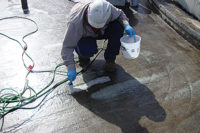Under tough economic pressures and uncertainty, it is imperative for property owners and managers to spend their monies wisely and manage their facilities assets properly. The ultimate goal should be to achieve maximum roof service life at the least possible cost. For this reason, roof maintenance — in conjunction with modern life-cycle assessment techniques — has never been more appropriate.
An “out of sight, out of mind” attitude toward roofing systems is dangerous. It’s also poor asset management. Too many building owners and managers have been burned by premature roof failure. When water leaks into a building, hard assets, corporate profits — and reputations — start taking a beating.
Unfortunately, we live in a world looking for short-term, quick fix solutions. We often compromise by taking the road of least resistance. When it comes to roofing, we frequently believe that if our roofs are not leaking, we don’t need to bother with them. However, this attitude does not reflect reality. Here are a few facts*:
• More than 80 percent of all roofs are replaced prematurely.
• The average building owner will spend more than $127,500 on roofing over the life of the building.
• The average cost of a new commercial roof is more than $42,500 (10,000 square foot average)
Repairs, maintenance and/or roof restoration costs thousands of dollars less than roof replacement.
• Roof maintenance programs are tax deductible.
• Roof maintenance programs typically cost about 1 to 3 percent per year of the estimated total replacement costs (maintenance cost depends on coverage).
• A roof maintenance program can save up to 50 percent over the life of a 30-year roof compared to replacing it every 15-20 years.
• A roof can leak for days, weeks, or months before it is noticed inside the building.
If a building owner or manager starts out with a problematic roof, the situation typically goes downhill, creating a maintenance nightmare.
So let’s assume we are starting out with a reasonably good roofing installation as part of a new construction process or a complete tear-off and re-roofing project.
Our goal is to immediately — from year No. 1 — take on a preventative program to ensure maximum service life of this roof.
Maintenance is a responsibility of ownership. It is required in most roofing manufacturers’ warranties. Also, No Dollar Limit (NDL) warranties don’t cover problems related to a lack of maintenance. If water backs up in a leaf-clogged roof drain, the service call can cost as much as $300.
Most commercial roofing contractors offer maintenance services. However, to be taken seriously, these contractors should be running separate, dedicated roof maintenance divisions staffed by their most experienced craftspeople. The bare-bones components of a maintenance package should consist of the something like the following:
• Visual roof inspections — including an on-site, 50-point inspection regimen.
• Photographic, digital and/or written documentation of the roof conditions.
• Quotes for recommended work.
• Repairs for deficient conditions.
• Routine maintenance as needed.
A maintenance program can even help building owners and managers with upfront roofing expenses. For example, a typical 20-year guarantee fee is about $17 per square foot. When it is extended using a roofing manufacturer’s Guarantee Extension program, the customer can save up to 20 percent of the per-year cost of guarantee coverage. Not to mention the annual inspections that will help prevent unexpected surprises and also catch small problems before they become big-ticket expenses.
Maintenance programs are also available for existing roof systems after a thorough roof audit is conducted by the roofing contractor.
Industry studies show that a proactive maintenance program can lower the average life-cycle cost of a roof to 14 cents per square foot. A “reactive” maintenance program — where the contractor is called in only after problems are discovered — can cost up to 25 cents per square foot. Finally, these studies show that roofs with proactive maintenance programs can last 21 years, compared to only 13 years with a reactive program.
In conclusion, property owners and managers needs to adopt a proactive roof maintenance protocol to get the maximum service lives from our roofing systems, and to reduce the collateral damage caused by leaking roofs at their facilities.






